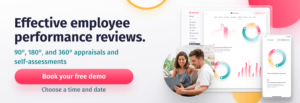The performance management cycle process has undergone significant changes over recent years. Traditionally, performance management was structured around formal annual appraisals and little more. More recently, companies are appreciating the benefits of implementing a more modern and rounded approach. With this approach, the performance management cycle is focused on continuous performance management and the gathering of 360 feedback.
As an employer, it’s important that you keep up with these changes in order to get the most from your workforce. This explains why, according to Gartner, 81% of HR leaders are currently making changes to the way they manage the cycle of performance.
In this guide, we will share everything you need to know about managing each stage of the performance management cycle so that you can set your company up for future success.
TABLE OF CONTENTS
- What is the Performance Management Cycle?
- What is Performance Management in HR?
- Issues with Performance Management
- Performance Management Models: A Comparison
- 4 Stages of the Performance Management Cycle Process
- Performance Management Cycle Example
- What Is Continuous Performance Management?
- Benefits of Continuous Performance Management
- ✅ Automate employee performance management with software
What is the Performance Management Cycle?
Employee performance management is a tool used by HR departments to monitor and evaluate the productivity of the workforce. It involves processes and activities that focus on skills, resources, and support in order to maintain and improve employee performance in line with an organization’s objectives. The ultimate aim is to create a high-performance culture where people can perform to the best of their abilities and produce the highest quality work.
The performance management cycle is part of the continuous performance management process. Examples of performance management processes and tools include regular performance appraisals, key performance indicators (KPIs), and performance management dashboards.
The cycle model is based on 4 key pillars: planning, monitoring, reviewing and rewarding. The aim is to establish performance goals in line with organizational objectives, and regularly monitor and review the progress of employees through 360 feedback. The model also promotes the rewarding of high-performing employees through established employee recognition programs.
Benefits of the Performance Management Cycle
The benefits of creating a solid performance management cycle include:
- Increased engagement, as your employees are 2.5 times more likely to engaged with their work if they feel you are holding them accountable for their performance.
- Higher retention levels, as your employees perform better when you give them regular feedback and support to develop their skills.
- Stronger relationships, as regular appraisals will help to develop trust between your managers and their teams.
- Better business results, as the entire workforce is aligned with a high performance cycle and working towards the same goals.
What is Performance Management in HR?
Human resources and performance management go hand in hand. They are both core components of an effective people management strategy. Put simply, they are both built around the concept of training, motivating, and managing employees in order to boost performance and promote professional growth. And this is vital for the success of your business.
The traditional model for conducting HR performance management was designed in the 1970s. With this model, employees would meet with their managers once a year to discuss their progress and performance. This led to a great deal of frustration for both managers and employees. It also resulted in many companies pulling back from the concept of reviewing performance and cries for “no more performance reviews!”
However, a lot has changed since then, especially given the huge shift we have experienced since Covid-19 and the new way of working. Companies are now adapting to more constructive and continuous models for human resource performance management. And they are seeing just how much this new model can benefit their business.
With the new updated model of continuous employee performance management:
-
- Managers meet regularly with employees to discuss their strengths and weaknesses (weekly or monthly catch-ups).
- Employees are regularly invited to give constructive feedback on their own performance and the support they feel they are receiving (360 feedback).
- Employee learning and development is prioritized.
- The focus is more on flexible short-term goal setting and the continual review of progress.
- Collaboration and communication are encouraged at all times.
- Employee recognition programs are used to engage employees and boost morale.
- It is much easier to identify and remedy poor performers.
Issues with Performance Management
Although traditional performance management systems were a step forward, many companies these days find them to be lacking. For one thing, trying to compress a year’s worth of performance into an annual appraisal is time-consuming. Especially when you consider that you need to do this for each of your employees. It makes far more sense to focus on continuous evaluation throughout the year and assess goal progress on a regular basis.
Other disadvantages of performance management systems used in the past include stress and pressure. With an annual review, an employee feels they only have one opportunity each year to raise any concerns relating to their job, development and working environment. And if you want your employees to improve their performance then they need regular feedback so that they know what areas they need to work on. A lack of clear goals and expectations and rating inconsistencies can also have a negative impact on employee performance.
Performance Management Models: A Comparison
Before we discuss the different stages in the performance cycle, let’s take a look at a couple of commonly used performance management models.
Most companies these days rely on one of two methods for evaluating performance: management by objectives, and 360 feedback.
Whilst these models are valuable, they can be lacking if you use them as a standalone tool. They are far more valuable if you use them as part of a broader performance management strategy where you take into account both solid metrics and employee feedback.
Management by Objectives
Management by objectives (MBO) is a strategic performance management model that is based on progress towards established employee performance metrics. With this management model, you assign points to assigned objectives based on their level of importance. You then award these points to employees when they reach their set goals.
This model is based on the belief that the right analytics can help you establish what is working well, whether the performance of employees is contributing to the achievement of business goals, and what performance improvement plan needs to be created in order to support future growth plans.
Other similar models include the 9 box grid (where a 9 box matrix template is used to visualize employee performance and potential on a scale) and stack ranking (where, controversially, you reward the top 20% of performers and fire the bottom 10%).
360 Degree Feedback
Another increasingly popular performance management model is 360 feedback. This is where you measure employee performance from all angles, not just from the perspective of your managers. This might include peer feedback, self-assessments, customer feedback and, in the case of managers, team feedback. You can collect feedback through surveys, interviews, self-appraisals, and regular 360 feedback sessions.
360 degree feedback is a multidimensional approach that can help your employees understand their strengths and weaknesses and the impact their performance levels have on the business as a whole. It can be a great tool for promoting self-reflection and encouraging your employees to be more accountable for their own performance levels.
4 Stages of the Performance Management Cycle Process
The cycle of performance is based on 4 key pillars: planning, monitoring, reviewing and rewarding.
Let’s take a look at each of these 4 stages in a bit more detail to help you understand the performance management cycle.
Plan
The first stage in the cycle of performance improvement is planning. This is where you meet with management and establish your organizational goals and objectives for the next performance management cycle. You obviously need to take your business strategy into account for this. However, you also need to consider the personal objectives of all employees and teams, including development goals, specific tasks, targets, actions and behaviors.
Once you’ve established individual and overall objectives, you need to create personal development plans for all your employees. These should detail all the skills, knowledge and behaviors employees need to develop in order to help the company reach its goals. You could also launch a performance coaching program to guide your employees.
Monitor
The next stage of the performance management cycle is monitoring. This is a key stage as it helps you ensure your employees are on track.
Compared to traditional models, with the performance management cycle you should focus on continuous monitoring. The more regularly you track performance and monitor your metrics, the more effective the model will be.
Ideally, managers should meet with employees on a monthly basis to discuss their performance. They should also offer guidance and support when needed. Make sure you adjust performance goals in line with gathered metrics and feedback. This will help you identify and address any concerns before they have a negative impact on performance.
Review
You might think that reviewing is the same as monitoring, but there is actually an important distinction here. Understanding this distinction will help you create a more effective performance management cycle.
When you monitor you focus on short, specific check-in sessions. These sessions help you see how an employee is progressing and if they need support. When you review, you take a step back and measure an employee’s overall development over the past cycle period. You should therefore hold your monitoring sessions at the end of each cycle.
During this review stage, which can be held together with a typical employee performance review, you should conduct a thorough 360 Performance Assessment. You should also encourage employees to conduct a self-appraisal so that they can assess their own development.
This 360 approach to performance appraisal benefits employees far more than just holding an annual salary review or occasional performance review for remote employees. It also helps you establish the impact of performance improvement activities so that you can make the necessary adjustments to your strategy.
Reward
The final stage in the performance management cycle is rewarding high-performing employees. Don’t skip this step as recognition is vital for employee motivation and engagement. You need to recognize and reward good work. You can use strategies like salary increases, bonuses, pay for performance, extra vacation time, or promotions.
The reward and recognition program you choose is up to you. What matters is that you show your employees that you value their hard work. This will motivate them to continue working hard and committing to the overall objectives of the company.
Performance Management Cycle Example
Let’s finish by taking a look at an example of an effective performance management cycle in action. Hopefully, this will help you understand the benefits of a cycle of performance in practical terms, not just as a theory.
The example we are going to look at is Adobe, the American multinational computer software company.
Adobe calculated that its managers were spending around 80,000 hours a year on performance reviews. Despite this huge number, employees still reported feeling dissatisfied with the process. Managers and employees were going through the motions, but it wasn’t having a positive impact on performance. On the contrary – employees were so demotivated that turnover was at an all-time high.
Something needed to change.
So Adobe came up with a solution. The company’s leadership team launched a new performance management cycle system. The key pillars Adobe chose for its system were (you guessed it) planning, monitoring, reviewing and rewarding.
Adobe trained its managers so that they were better equipped to perform more regular check-ins and offer guidance and support when needed. The company gave management more freedom in how they structured their employee review sessions. Managers also had more discretion in salaries and promotions. And Adobe regularly invited its employees to participate in ‘pulse surveys’ to evaluate how well they thought their managers were doing.
As a result of this simple shift to a modern performance management cycle strategy, turnover dropped by 30% and employee performance and motivation levels soared.
What Is Continuous Performance Management?
Continuous performance management (CPM) is an HR tool for tracking, evaluating, and improving employee performance. It is based on the principles of continuous analysis, agile management and real-time feedback. It involves setting standards and expectations for performance and guiding employees to help them meet their goals. Employees are then monitored regularly and assessed against their performance standards and goals. This helps companies identify and address any issues with poor performance.
The most important aspect of CPM is maintaining regular reviews and appraisals. This creates a culture of open two-way dialogue (not just top-down evaluation) and encourages employees to take responsibility for their own professional development. This, in turn, builds trust within the company, creates stronger relationships between managers and employees, and helps employees realise their true potential for the good of the business. Companies that implement a CPM strategy find that it increases employee engagement and performance, and improves communication and retention levels.
Traditional Performance Management
Performance management is not a new concept. In fact, it could arguably be traced right back to the Egyptians and their use of whips to encourage increased performance. Thankfully things have moved on a bit since then. More traditional performance management systems can be traced back to the start of the Industrial Revolution in the late 1800s. During this period, employees were viewed as “workers” and their output was easy to measure: hours worked, goods produced, etc. The focus was very much on what an employee had produced, rather than what they were capable of.
This perspective began to shift in the 1960s when a more holistic approach was adopted. This new method had a greater focus on self-appraisal and was more concerned with what an employee could achieve in the future with the right support and development. From this point on, traditional performance management typically involved self-evaluation, manager evaluation, scoring and annual appraisals. But appraisals were still very much tied in with bonuses and promotions (such as performance-related pay) rather than individual performance and the impact it had on a company’s goals. Today, continuous performance management is much more prevalent.
Benefits of Continuous Performance Management
How can continuous performance management benefit your company? Let’s count:
-
- As an employer, you will maintain a clear overview of how each employee in your company is performing. Are they delivering as expected? How could they improve?
- Continuous performance management doesn’t rely on top-down input like the traditional employee appraisals system. Instead, you can collect feedback from all directions, using 360° reviews. This gives you a fuller picture of how every cog in the company is performing.
- Continuous performance monitoring establishes open channels of communication and transparent dialogue. This helps to build trust in your company.
- You get better quality key performance indicator (KPI) data as you are gathering information from numerous sources (conversations, check-ins, progress updates, peer reviews, etc.). You can leverage this data not only to gain insight into your workforce but to reduce discrimination from unconscious bias.
- When employees are able to participate in an ongoing conversation, they feel that their voice is important. It is important that they know they have a channel to air any concerns or grievances. It improves communication, strengthens employer-employee relations, and boosts engagement and retention.
-
- Rather than overloading your HR department with the burden of annual appraisals, you can gather data consistently throughout the year. Not only does this reduce your workload, but it also provides you with real-time data on all your employees. You also have access to more key data for each employee so you know exactly what needs to be discussed when you hold a performance evaluation meeting.







